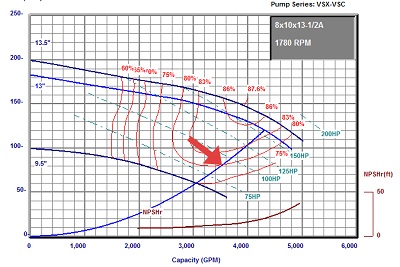| Printer Friendly (PDF)
The Pump Affinity Laws are used to determine the system curve. If we know the point of operation on a pump curve, we can determine the effect of trimming impellers or changing speeds.
Let’s look at an example. The engineer specified an ITT Bell and Gossett VSX- VSC double suction pump in a closed chilled water system. The capacity is 3500 GPM at 140 ft head. They selected the B&G VSC because of the great benefits to the owner. Benefits that include silicon carbide unitized seals, ease of service, ANSI/OSHA coupler guard, and a good 15 other reasons. The pump selected is shown below. The balancing contractor reads the pump out after a proportional balance and finds the operation point to be 4300 GPM at 120 ft. This means the pump is oversized. The over sizing may be a result of pipe changes during the construction, estimates of pressure drop through equipment, changes in equipment from the basis of design, or safety factors. The balance contractor is asked what the impeller should be trimmed to. The balance contractor takes scale 5 of the System Syzer and sets 4300 GPM against 120 feet. Using the B&G system syzer the field tech continues to plot the system curve below. The intersection of the system curve and 3500 GPM is at 80 feet. The impeller could be trimmed to 10.75”. If you would like to download the electronic system syzer go to http://www.bellgossett.com/BG-SystemSyzer.asp. |
 |
Thank you for using products sold by R. L. Deppmann Company in Michigan and Ohio!
Disclaimer: R. L. Deppmann and it’s affiliates can not be held liable for issues caused by use of the information on this page. While the information comes from many years of experience and can be a valuable tool, it may not take into account special circumstances in your system and we therefore can not take responsibility for actions that result from this information. Please feel free to contact us if you do have any questions.
Archives – Click here for Past Articles



